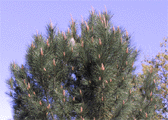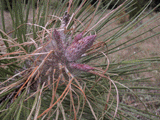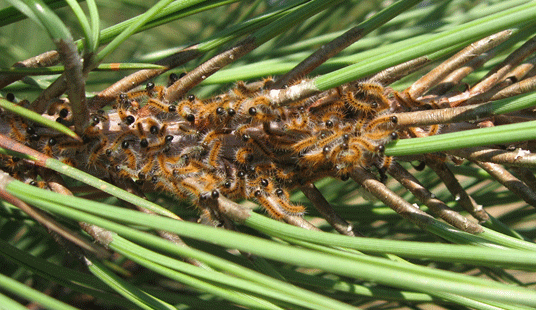Thaumetopoea pityocampa Schiff.
Lepidoptera. - fam. Bombycideae
Synonyms : Cnethocampa pityocampa - Gastropacha pityocampa. French name : Bombyx processionnaire du Pin.
Size : 30 to 40 mm.
Visible Damage: Gnawed or partially eaten pine needles.
General Character and Habits: In southern France this butterfly often
invades entire districts planted in pines and its caterpillar stage causes
extensive damage.
The butterfly appears in June or July and the female lays her eggs around the
pine needles, forming a ring which appears like a small hand muff.

|
The white spot in the crown is a caterpillar nest on a Pinus pinaster
After one month, the caterpillar hatches from the egg and
immediately it begins to eat the nearest needles and to weave a silk nest
where it eats all of the needles incorporated therein. When this supply of
needles is consumed, the caterpillar repeats the process, each time building
a larger nest with more needles to be consumed. The caterpillar continues to
build progressively larger nests, each time consuming more needles until it
reaches about 20 mm. length. Then the caterpillar builds a large white silky
pocket at the end of the pine shoot. This pouch has an ovoid or conical
shape, incorporating many needles in its silky threads. During the daytime
the caterpillars take refuge in their pouches and then at night they go out,
moving in procession, to feed on pine needles. They molt (shed their coats)
as they grow larger through the winter, reaching about 40 mm. in length by
the next June. Then they drop from the pine tree and bury themselves in the
soil where they have their chrysallis stage in a cocoon.
The caterpillars have irritating hairs on their bodies which
detach and embed into human skin with direct contact. This causes a severely
painful itching sensation, so it best to avoid touching the catepillars and
to be especially cautious with dry windy conditions.
Method of Control: Cut the shoots with the silky nests, best on a rainy
morning or cold winter day, and burn them immediately.
Observations in the Arboretum: These caterpillars were observed so far on the following Pinus species:
Pinus nigra (the most common pines in the region above 300 meters)
Pinus sylvestris
Pinus ponderosa
Pinus pinaster
Pinus coulteri
Pinus attenuata (curiously on this species the caterpillars seem to have a problem to establish a nest, migrating often to another shoot, as if the tree was able to defend itself)

Very young nest on a Pinus ponderosa.
The empty eggs can be seen behind the buds (dark colour), while some very small caterpillars are feeding
on the needles (right side). The nest encircles the shoot.
(Click on the photo to enlarge it to see all details.)
Photo taken on the 20 August 2001.

The caterpillars just left their previous nest to go feeding on another shoot of the same branch and build a second nest.
Photos taken on the 6 September 2009 on a Pinus ponderosa.


